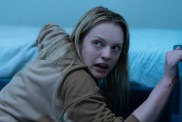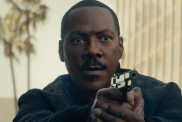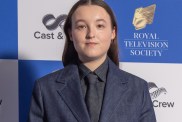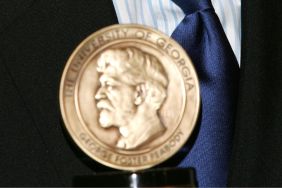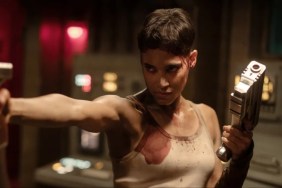Austrian filmmaking auteur Michael Haneke has long been somewhat of an enigma even in the arthouse world due to his unconventional forays into genre every few years. After making critically-praised films like The Piano Teacher and Caché, both Cannes prize winners, Haneke decided to make a shot-for-shot English language remake of his dark 1997 thriller Funny Games, not something one might expect even from one of the more eclectic filmmakers.
Haneke has returned with The White Ribbon, his most accomplished film to date, which has already received a great deal of acclaim–after five nominations, it’s Haneke’s first film to win the coveted Palm D’Or at Cannes–as well as being tapped by Germany as its submission for the Foreign Language Oscar.
Shot entirely in black and white, the film takes place in a small German village in the years leading up to World War I, a feudal community that’s been shocked by a series of tragic mishaps that have the adults in conflict and their children behaving oddly. In the middle of that, a school teacher (Christian Friedel) has fallen for the Baron’s young nanny Eva (Leonie Benesch), a relationship that’s tested by the horrifying events taking place in the village.
That might possibly be the most simplified way of explaining this rich and compelling tale that brings Haneke into territory that’s been explored in the past by the likes of Mike Leigh, only Haneke does it in a far more analytical way, allowing us behind the closed doors of the different families in this community to watch what may be their normal every day routine or could be something far more sinister.
ComingSoon.net had a chance to talk with Herr Haneke a few months back when he was in New York for the New York Film Festival at Lincoln Center. (Note: Even though Haneke does speak and understand a little bit of English, he chose to use an interpreter, so some of the responses might not be exactly in his own words.)
ComingSoon.net: I hadn’t read anything about this movie before seeing it, so I saw it fresh.
Michael Haneke: The best way to see a movie. (chuckles)
CS: Absolutely, and I was wondering if this was a completely original story or whether it was based on a story you might have heard as kid.
Haneke: Completely original.
CS: What made you want to work in that setting and environment?
Haneke: It was my intention from the very beginning to choose that time and place to make the film. I knew I wanted to make the film North Germany in the context of the Protestant culture.
CS: Did you have family who lived in that area at that time?
Haneke: No, not at all. I almost never make films that have anything to do with myself.
CS: Fair enough. With that in mind, when you decided to set it there, what kind of research did you have to do? How important was it to be realistic to those times?
Haneke: I always strive to be as precise and exact as possible. In this case, then yes, I did a lot of research to do that, but I’m aware that nevertheless the film remains an artifact. It’s not a contemporary document that was shot at the time. You do as much as you can to get as close as you can to reality, but nonetheless I’m always aware that it’s only an approach and never the reality itself.

CS: So what was involved with that? A lot of reading? Did you go up to that area and try to find people who had parents around at that time?
Haneke: Yes, I read a great deal about pedagogical methods, educational methods of the period, and how life was in rural villages at the time. Also, for recreating the costumes and locations, we looked at entire harddrives full of photographs from the period.
CS: The photos are interesting because you decided to film this in black and white and had a very specific look, so was that influenced by those photos?
Haneke: There’s a well-known German photographer of the time, August Sander, who really is the photographer of the period in Germany. There’s a collection of his works that comprises many volumes, and the pictures are all extremely precise, extremely sharp in the image, so we looked at those a great deal in preparing for the film.
CS: How do you work with your production designer and art director on a movie like this? When you’re looking at those pictures, you can’t tell what colors are in the pictures, just shades, so how did you determine the colors, realizing that they would only be seen in black and white?
Haneke: For all of us on the film, it was a new experience, because almost no one today has experience working in black and white. Nonetheless, we did an enormous amount of tests to see how it would look before we started shooting. We did lots of tests to see how we could light the interiors because we wanted as much as possible to use realistic light sources, candlelight and the kerosene light. We had to shoot on color film stock because black and white isn’t as sensitive to color, then once the film had been shot, we transferred it digitally into black and white. However, even on the set, while we were looking at the takes through monitors, the monitors were set to black and white because we had to see how the colors would transfer to black and white.
CS: Obviously, you must have approached this movie different from some of your other films, but do you generally approach every film you do completely different or do you have a way that you tackle films that’s similar?
Haneke: Yes, the preparation for each film is different. I try to find a different aesthetic approach to each film. To me, my quest consists in finding the appropriate aesthetic approach for each story, and each time, it’s different. But with each film, I’m more or less working with the same crew, it’s much easier to understand what you want, so you don’t have to start from the very beginning again in explaining. People understand your intentions. And that’s the same reason why I often use the same actors. (chuckles)
CS: Also, why was it important in telling this story right before World War I? Did you feel that what’s happening in this community was a cross-section of what was happening in the world in a smaller environment?
Haneke: I don’t think that it’s a coincidence that the film takes place in Germany at this specific time but nevertheless, it would be a wrong interpretation if one were to only see the film as depicting that period. I think that the social and psychological and political mechanisms that are present in the film are present in every age, although they take different forms. The same mechanisms are at work even today. I like to say that Germans should see this film as a film about Germany, but in other countries, people should see the film about their own countries.
CS: Absolutely… I can see that this same environment could be the Southern plantations or feudal Japan, because there’s a lot of communities similar to this one over the years in different places. The difference between classes is especially interesting because that was a time when there was an obvious divide between the rich people and everyone working for them. Was that something you wanted to explore from the very beginning or did that just come about from setting the story there?
Haneke: You’re absolutely right. The society that is depicted at that time with its class relationships was a feudal society that ended in the cataclysm of World War I after having existed for thousands of years. I think however that the film uses this period to depict mechanisms that don’t only take place with feudal societies. It’s simply in a feudal society easier for me as a filmmaker to depict those mechanisms.

CS: The kids are such an important part of this movie and in some ways, this story really is about them, so can you talk about that? Let’s start with the casting of them, because you knew you were making a movie which required a lot of child actors, and you’d have to find kids who could really stand up to some of these more experienced actors. Can you talk about how you went about finding them and knowing that they perform in the way you needed?
Haneke: If the children are talented, they’re good; if not talented, it’s difficult. It’s not that they work differently from professional actors. What was unusual however in this film is that it required so many different children to play so many difficult roles. That was my greatest fear before beginning the production, that we wouldn’t be able to find them, and that’s why we started casting six months before production and met over 7,000 children to find the ones that we did. That’s quite unusual, so it required an enormous amount of work and preparation.
CS: I know that you came from a theater background originally, so did that come more into play for this movie than some of your other ones, or are you normally someone who likes a lot of rehearsals before shooting?
Haneke: I never rehearse any of my scenes. There was one exception in this film and that was the scenes involving the teacher and Eva, but it wasn’t so much that I was rehearsing the scenes to prepare for shooting, but rather, I wanted to see how they worked as a couple, and for that reason, I had shot the teacher with five or six other women and the actress who plays Eva, I shot with the same number of other young men to see which couple worked best. But other than that, I never rehearse. It’s my feeling that rehearsal leads to limited spontaneity.
CS: With that in mind, do you just have to assume everyone knows their lines and are prepared or do you just end up shooting a lot more takes than you might normally?
Haneke: Well, I absolutely expected that the actors would know their lines. It’s a basic requirement of an actor, but then it’s not so much about the preparation whether I get what I want. It depends on whether they’re able to give me the emotion I’m looking for in a scene and whether I have to do more takes than that. You can never predict how many takes you’ll need. Sometimes scenes you think are very difficult go quickly and other times, scenes that you imagine will be very easy prove to be very difficult and you have to do many more takes than you thought. It’s not only the actors who can make you have to redo a scene, it can be any number of other sources. The camera crew might make a mistake. There are thousands of possibilities for errors creeping into a scene, and in general, the longer and more complicated a shot is, the higher the probability that something is going to go wrong.
CS: I wanted to ask about that because you not only have to get these performances from your actors but also the technical aspects of making a period piece, so I was wondering how hard it was to balance those things and not let one overpower the other?
Haneke: I always try when working on set to allow the actors as much freedom as possible. In fact, when I’m on set, I tend to terrorize the crew and to spoil my actors. It’s by choice, because when I see my students working (Haneke also teaches filmmaking), they always tend to treat the technicians as the most important part of the process and the actors are simply left to their own devices, but actors can only be good when they feel protected.
CS: I want to talk about some of the decisions that went into making the movie, such as the music… or the lack of music. The only time we hear any is when someone in the story is playing an instrument like in the fair scene. Why did you decide to go in that direction?
Haneke: In real life, you only hear music when it’s actually being played. (chuckles) In general, musical score is only used to cover up the weaknesses of the film. If the film works dramatically and there’s enough tension, then you don’t need music. I always find it too easy. It’s cheap and cowardly using music.

CS: Is that something you realized from the very beginning or when you’re editing? And I’m not sure I ever noticed that but has that always been the case with your movies and I’ve never noticed?
Haneke: No, I haven’t used music in any of my films.
CS: Wow, then it obviously must be working because I’ve never noticed that until this movie. I would think most filmmakers, especially when making a period piece, would have tons of music. There are a lot of things left open-ended and loose ends and things that you leave for the audience to interpret, which is great. Do you always know exactly what is meant or implied by those scenes? Example, the way Eva acts when the teacher wants to take her on a picnic. She reacts absolutely horrified by the idea, but we never find out why.
Haneke: I’m not sure that scene you’re referring to is that complicated. I think that it’s simply, especially at the time, that a young girl who is on her own with a young man who might fear that he had certain improper intentions, but it wasn’t limited to that period, I think it was the case in the ’50s and who knows? Perhaps even today young girls would be worried about what a young man might want from them. I don’t think it’s a secret and I think it’s general behavior among young teenage girls.
CS: I think why it’s so affecting is that we’ve seen all these horrible things happening to kids over the course of the movie and with her reaction, you start to wonder what might have happened to her? You kind of wonder.
Haneke: If that’s your interpretation, that’s fine. (laughs)
CS: I want to talk about the reactions to your work, not just this, but to all of your movies. Your work is very polarizing and always has been, between moviegoers or critics. Every movie you do, there are those who love them and those who hate them. Do you ever pay attention to any of that? Do you allow any of that to affect or influence your decisions?
Haneke: I think that when you try to drill as deeply into a society and deal with social issues, then there are necessarily going to be people, those who appreciate you and those who don’t appreciate you. I have to live with that. It’s not a question of changing my gaze or changing the way I deal with certain things so that some people like me better. Even then it’s impossible to please everyone, so necessarily, if you’re trying to treat social issues as possible and also to respect the spectator and take them as seriously as possible, then you have to deal with things honestly. Of course, there will be those who like your approach who don’t like your approach. That’s really their own decision, that’s up to them. I’m always wary of dramas that everyone agrees on.
CS: Do you read any of the reviews, good or bad, about your work? Or once you finish a movie, you’re more concerned with what to do next?
Haneke: I read the important critics.
CS: Fair enough. A question I ask a lot of filmmakers is one about art vs. commerce. When you make a movie, it generally will cost a lot of money, but I would think most filmmakers aren’t making movies to make money. They have a story to tell or something they need to share, but making movies require financiers and studio money, so how do you convince someone to finance a movie like this which is more about the art and story than being commercial?
Haneke: Every time you want to make a film, it’s as easy or difficult depending on the result of your last film. You’re only as good as your last film. If you’ve made a flop, then it’s going to be very difficult to obtain financing for your next film. If your previous film was a success, it will be much easier but all directors face that, whether they’re making commercial films or arthouse films. Anyway, what is success? Is success being a box office hit? Does it mean prizes that you’ve won and lots of invitations to festivals? Or is it in the best case of all, both commercial success and critical esteem? That’s the best, but I think that if you seek to keep those in mind, to try and change your film to reach either of those goals, then you’re necessarily going to lose your personal voice.
CS: I’ve been curious about that because as I said, I talk to a lot of filmmakers about it and Steven Soderbergh was one who said that he does feel he has to make movies that make money in order to do the more personal projects. I was curious whether that affected you at all?
Haneke: Thank God I haven’t had to do that yet and it’s certainly not my intention to. If that were the case, I’d choose instead to either do nothing or direct operas.
CS: Nice. Have you started developing anything else yet to do next?
Haneke: Yes, I am in fact working on another project but since my time until the end of November is fully booked giving interviews for this film, I don’t want to discuss the next film yet. It’s too early.
The White Ribbon opens in New York and L.A. on Wednesday, December 30, and then will expand into more cities in the New Year.
